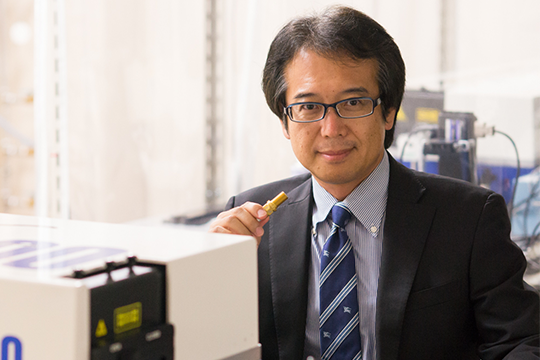Research Theme
Micro Solid-State Photonics
Keywords
Solid-State Lasers, Nonlinear Optics, Micro Solid-State Photonics
“Micro Solid-State Photonics” based on the micro domain structure and boundary controlled materials, opens new horizon in the laser science. The engineered materials of micro and/or microchip solid-state, ceramic and single-crystal, lasers can provide excellent spatial mode quality and narrow linewidths with enough power1-5). High-brightness nature of these lasers has allowed efficient light-matter interaction and wavelength extension by nonlinear frequency conversion: the world first YAG ceramic microchip laser ignited car 6-8), highly efficiency broad frequency conversions from the wavelength of 118 nm VUV9) until MIR of 11 μm4),10), in addition THz to millimeter wave of 0.1-0.8 mm11),12) , and so on. Here, the quasi phase matching (QPM) is an attractive technique for compensating phase velocity dispersion in frequency conversion. Lately, we propose a new architecture to realize a monolithic multi-disk laser by the inter layer assisted surface activated bonding (il-SAB)13). This multiple thin-disk or chip gain medium for distributed face cooling (DFC) structure can manage the high-power and high-field laser with high-gain compact system. Besides, QPM-structured crystal quartz constructed by multi-plate stacking could be promising as a high-power and reliable VUV frequency conversion devices14). These downsized and modularized tiny integrated lasers (TILA) promise the extremely high-brightness lasers to open up the new science, such as laser driven electron accelerator toward table-top XFEL with RIKEN SPring-8 Center11),15),16), and innovation by the compact power laser cooperation with TILA consortium17) (Fig. 1).

Fig. 1 TILA consortium toward
“Laser Science and Innovation” by micro solid-state photonics.
Selected Publications
-
T. Taira, et al., Opt. Lett. 16 (24) 1955 (1991).
-
T. Taira, et al., IEEE J. Sel. Top. Quantum Electron. 3 (1) 100 (1997).
-
T. Taira, IEEE J. Sel. Top. Quantum Electron. 13 (3) 798 (2007).
-
T. Taira, Opt. Mater. Express 1 (5) 1040 (2011).
-
Y. Sato, et al., Scientific Reports 7, 10732 (2017).
-
H. Sakai, et al., Opt. Express 16 (24) 19891 (2008).
-
M. Tsunekane, et al., IEEE J. Quantum Electron. 46 (2) 277 (2010).
-
T. Taira, et al., The 1st Laser Ignition Conference ’13, OPIC ’13, Yokohama, April 23-26, LIC3-1 (2013).
-
R. Bhandari, et al., Opt. Express 21 (23) 28849 (2013).
-
M. Miyazaki, et al., Phys. Chem. Chem. Phys. 11, 6098 (2009).
-
S. Hayashi, et al., Scientific Reports 4, 5045 (2014).
-
S.W. Jolly, et al., Nature Commun. 10 (2591), 1 (2019).
-
L. Zheng, et al., Opt. Mater. Express 7 (9), 3214 (2017).
-
H. Ishizuki, et al., Opt. Mater. Express 8 (5), 1259 (2018).
-
N.H. Matlis, et al., Nuclear Inst. and Methods in Physics Research A, 909, 27 (2018).
-
https://www.riken.jp/en/research/labs/rsc/innov_light_src/laser_drive_electron_accel_tech/index.html
-
https://tila.ims.ac.jp/en/
-
Y. Sano et. al., Materials, 11, 1716 (2021).
-
H. Ohba et. al., IEEJ Journal, 142, 77 (2022).


